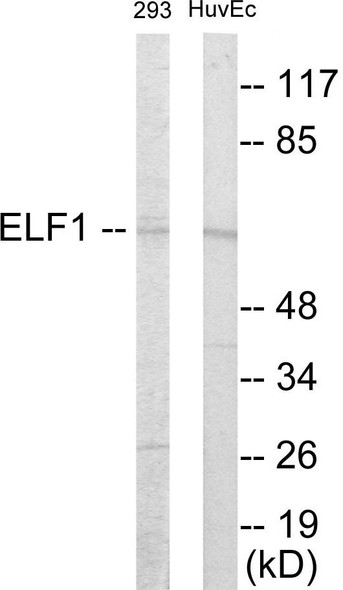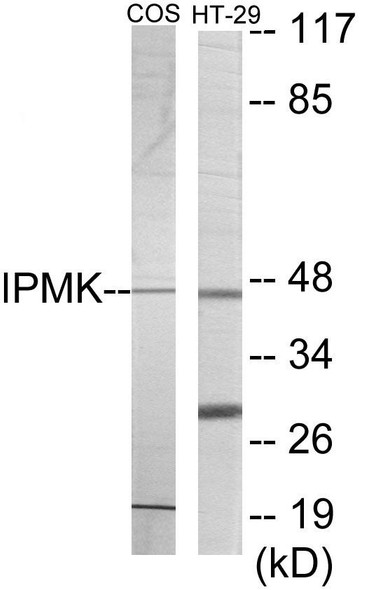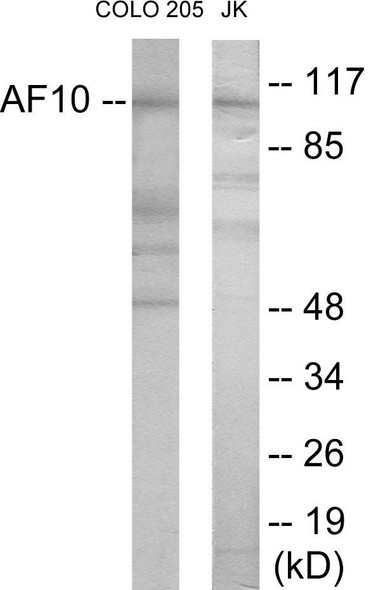Cell Death
RBM5 Colorimetric Cell-Based ELISA
- SKU:
- CBCAB01035
- Product Type:
- ELISA Kit
- ELISA Type:
- Cell Based
- Research Area:
- Cell Death
- Reactivity:
- Human
- Reactivity:
- Mouse
- Detection Method:
- Colorimetric
Description
| Product Name: | RBM5 Colorimetric Cell-Based ELISA |
| Product Code: | CBCAB01035 |
| ELISA Type: | Cell-Based |
| Target: | RBM5 |
| Reactivity: | Human, Mouse |
| Dynamic Range: | > 5000 Cells |
| Detection Method: | Colorimetric 450 nmStorage/Stability:4°C/6 Months |
| Format: | 96-Well Microplate |
The RBM5 Colorimetric Cell-Based ELISA Kit is a convenient, lysate-free, high throughput and sensitive assay kit that can detect RBM5 protein expression profile in cells. The kit can be used for measuring the relative amounts of RBM5 in cultured cells as well as screening for the effects that various treatments, inhibitors (ie siRNA or chemicals), or activators have on RBM5.
Qualitative determination of RBM5 concentration is achieved by an indirect ELISA format. In essence, RBM5 is captured by RBM5-specific primary antibodies while the HRP-conjugated secondary antibodies bind the Fc region of the primary antibody. Through this binding, the HRP enzyme conjugated to the secondary antibody can catalyze a colorimetric reaction upon substrate addition. Due to the qualitative nature of the Cell-Based ELISA, multiple normalization methods are needed:
| 1. | A monoclonal antibody specific for human GAPDH is included to serve as an internal positive control in normalizing the target absorbance values. |
| 2. | Following the colorimetric measurement of HRP activity via substrate addition, the Crystal Violet whole-cell staining method may be used to determine cell density. After staining, the results can be analysed by normalizing the absorbance values to cell amounts, by which the plating difference can be adjusted. |
| Database Information: | Gene ID: 10181, UniProt ID: P52756, OMIM: 606884, Unigene: Hs.439480 |
| Gene Symbol: | RBM5 |
| Sub Type: | None |
| UniProt Protein Function: | RBM5: Component of the spliceosome A complex. Regulates alternative splicing of a number of mRNAs. May modulate splice site pairing after recruitment of the U1 and U2 snRNPs to the 5' and 3' splice sites of the intron. May both positively and negatively regulate aopotosis by regulating the alternative splicing of several genes involved in this process, including FAS and CASP2/caspase-2. In the case of FAS, promotes exclusion of exon 6 thereby producing a soluble form of FAS that inhibits apoptosis. In the case of CASP2/caspase-2, promotes exclusion of exon 9 thereby producing a catalytically active form of CASP2/Caspase-2 that induces apoptosis. Belongs to the RBM5/RBM10 family. 5 isoforms of the human protein are produced by alternative splicing. |
| UniProt Protein Details: | Protein type:RNA splicing; C2H2-type zinc finger protein; Apoptosis; Cell cycle regulation; RNA processing; RNA-binding Chromosomal Location of Human Ortholog: 3p21.3 Cellular Component: nucleoplasm; nucleus; spliceosome Molecular Function:DNA binding; mRNA binding; protein binding; RNA binding Biological Process: negative regulation of cell proliferation; nuclear mRNA splicing, via spliceosome; positive regulation of apoptosis; regulation of alternative nuclear mRNA splicing, via spliceosome; RNA processing; spliceosome assembly |
| NCBI Summary: | This gene is a candidate tumor suppressor gene which encodes a nuclear RNA binding protein that is a component of the spliceosome A complex. The encoded protein plays a role in the induction of cell cycle arrest and apoptosis through pre-mRNA splicing of multiple target genes including the tumor suppressor protein p53. This gene is located within the tumor suppressor region 3p21.3, and may play a role in the inhibition of tumor transformation and progression of several malignancies including lung cancer. [provided by RefSeq, Oct 2011] |
| UniProt Code: | P52756 |
| NCBI GenInfo Identifier: | 13124794 |
| NCBI Gene ID: | 10181 |
| NCBI Accession: | P52756.2 |
| UniProt Secondary Accession: | P52756,Q93021, Q9BU14, Q9HDA6, Q9UKY8, Q9UL24, B2RA45 B4DM16, B4DMF9, B4DZ63, |
| UniProt Related Accession: | P52756 |
| Molecular Weight: | 17,891 Da |
| NCBI Full Name: | RNA-binding protein 5 |
| NCBI Synonym Full Names: | RNA binding motif protein 5 |
| NCBI Official Symbol: | RBM5 |
| NCBI Official Synonym Symbols: | G15; H37; RMB5; LUCA15 |
| NCBI Protein Information: | RNA-binding protein 5 |
| UniProt Protein Name: | RNA-binding protein 5 |
| UniProt Synonym Protein Names: | Protein G15; Putative tumor suppressor LUCA15; RNA-binding motif protein 5; Renal carcinoma antigen NY-REN-9 |
| Protein Family: | RNA-binding protein |
| UniProt Gene Name: | RBM5 |
| UniProt Entry Name: | RBM5_HUMAN |
| Component | Quantity |
| 96-Well Cell Culture Clear-Bottom Microplate | 2 plates |
| 10X TBS | 24 mL |
| Quenching Buffer | 24 mL |
| Blocking Buffer | 50 mL |
| 15X Wash Buffer | 50 mL |
| Primary Antibody Diluent | 12 mL |
| 100x Anti-Phospho Target Antibody | 60 µL |
| 100x Anti-Target Antibody | 60 µL |
| Anti-GAPDH Antibody | 60 µL |
| HRP-Conjugated Anti-Rabbit IgG Antibody | 12 mL |
| HRP-Conjugated Anti-Mouse IgG Antibody | 12 mL |
| SDS Solution | 12 mL |
| Stop Solution | 24 mL |
| Ready-to-Use Substrate | 12 mL |
| Crystal Violet Solution | 12 mL |
| Adhesive Plate Seals | 2 seals |
The following materials and/or equipment are NOT provided in this kit but are necessary to successfully conduct the experiment:
- Microplate reader able to measure absorbance at 450 nm and/or 595 nm for Crystal Violet Cell Staining (Optional)
- Micropipettes with capability of measuring volumes ranging from 1 µL to 1 ml
- 37% formaldehyde (Sigma Cat# F-8775) or formaldehyde from other sources
- Squirt bottle, manifold dispenser, multichannel pipette reservoir or automated microplate washer
- Graph paper or computer software capable of generating or displaying logarithmic functions
- Absorbent papers or vacuum aspirator
- Test tubes or microfuge tubes capable of storing ≥1 ml
- Poly-L-Lysine (Sigma Cat# P4832 for suspension cells)
- Orbital shaker (optional)
- Deionized or sterile water
*Note: Protocols are specific to each batch/lot. For the correct instructions please follow the protocol included in your kit.
| Step | Procedure |
| 1. | Seed 200 µL of 20,000 adherent cells in culture medium in each well of a 96-well plate. The plates included in the kit are sterile and treated for cell culture. For suspension cells and loosely attached cells, coat the plates with 100 µL of 10 µg/ml Poly-L-Lysine (not included) to each well of a 96-well plate for 30 minutes at 37°C prior to adding cells. |
| 2. | Incubate the cells for overnight at 37°C, 5% CO2. |
| 3. | Treat the cells as desired. |
| 4. | Remove the cell culture medium and rinse with 200 µL of 1x TBS, twice. |
| 5. | Fix the cells by incubating with 100 µL of Fixing Solution for 20 minutes at room temperature. The 4% formaldehyde is used for adherent cells and 8% formaldehyde is used for suspension cells and loosely attached cells. |
| 6. | Remove the Fixing Solution and wash the plate 3 times with 200 µL 1x Wash Buffer for five minutes each time with gentle shaking on the orbital shaker. The plate can be stored at 4°C for a week. |
| 7. | Add 100 µL of Quenching Buffer and incubate for 20 minutes at room temperature. |
| 8. | Wash the plate 3 times with 1x Wash Buffer for 5 minutes each time. |
| 9. | Add 200 µL of Blocking Buffer and incubate for 1 hour at room temperature. |
| 10. | Wash 3 times with 200 µL of 1x Wash Buffer for 5 minutes each time. |
| 11. | Add 50 µL of 1x primary antibodies (Anti-RBM5 Antibody and/or Anti-GAPDH Antibody) to the corresponding wells, cover with Parafilm and incubate for 16 hours (overnight) at 4°C. If the target expression is known to be high, incubate for 2 hours at room temperature. |
| 12. | Wash 3 times with 200 µL of 1x Wash Buffer for 5 minutes each time. |
| 13. | Add 50 µL of 1x secondary antibodies (HRP-Conjugated AntiRabbit IgG Antibody or HRP-Conjugated Anti-Mouse IgG Antibody) to corresponding wells and incubate for 1.5 hours at room temperature. |
| 14. | Wash 3 times with 200 µL of 1x Wash Buffer for 5 minutes each time. |
| 15. | Add 50 µL of Ready-to-Use Substrate to each well and incubate for 30 minutes at room temperature in the dark. |
| 16. | Add 50 µL of Stop Solution to each well and read OD at 450 nm immediately using the microplate reader. |
(Additional Crystal Violet staining may be performed if desired – details of this may be found in the kit technical manual.)






